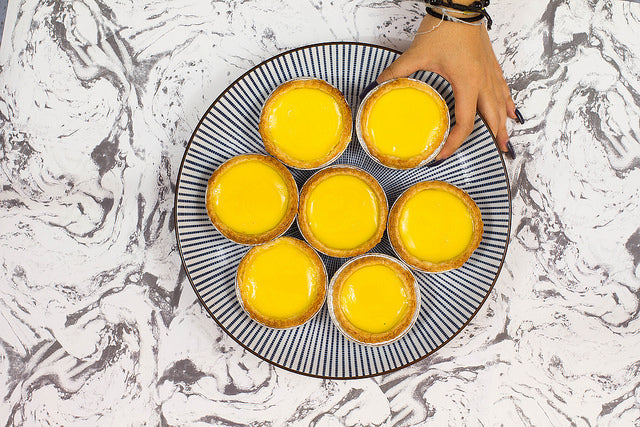
A Brief History Egg Tarts, From Portuguese Monks to Hong Kong Hipsters
That creamy filling. That flaky crust. The way it’s so easy — too easy — to eat five in one sitting. The Chinese egg tart.
We love this mildly sweet treat, and while every day is dan tat day to us, World Egg Day today (and every second Friday of October) gives us even more reason to celebrate. Savor these eight things you might know about one of our favorite Asian desserts.
It has English and Portuguese origins
Just as the seemingly quintessential American ketchup has Chinese origins, the seemingly quintessential Chinese dan tat actually has its roots in Great Britain and Portugal. However, both the English and Portuguese versions ultimately come from the king of pastries, France, while the egg tarts you'll find in Chinese restaurants and bakeries today are distinct from their European cousins.
Egg tarts might have been served during Henry IV’s coronation
Also called custard tarts, English-style egg tarts have been around since at least the medieval times. Known back then as doucets or darioles, they were served at the coronation banquet of Henry IV in 1399.
The Portuguese egg tart was invented thanks to monks and laundry
With its distinctive caramelized, creme brulee-like topping, pastéis de nata are arguably Portugal’s favorite dessert. They were supposedly first made in the 13th century by monks in the Jerónimos Monastery in Lisbon. Legend says the monks had been based in France, where they learned of delectable pastries, and that they needed a way to use up the yolks separated from the egg whites that were used to starch clothing. What better way than in yummy tarts?
You can still get a version of these tarts in Lisbon today
Sensing impending closure after the the Liberal Revolution of 1820, the enterprising monks of the Jerónimos Monastery started selling pastéis de nata to a nearby sugar refinery. In 1834, their monastery indeed closed and the recipe was sold to said sugar refinery. Three years later, the refinery owners opened Fábrica de Pastéis de Belém, which is run by descendants of the original owners and where you can still get egg tarts based on the ancient recipe today.
Egg tarts rode a slow boat to China
So how did egg tarts make their way to China? Presumably through exploration and colonization. Portugal, with its long history of naval exploration, first landed in Guangzhou Province in 1513 while Hong Kong became a British colony in the early 1840s.
The Chinese-style egg tart came about due to department store competition
Legend says that in 1920s Guangzhou, competition between department stores was tough. To rise to the challenge, every week the chefs of each store (department stores had chefs, who knew?) would invent a new goodie to draw in customers. Thus, the egg tart was born.
Egg tarts were introduced in Hong Kong via their famed “tea restaurants”
After World War II, eating establishments called cha chaan tengs, literally “tea restaurants,” started popping up in Hong Kong. Casual and inexpensive, they specialized in Western-style dishes with a Chinese twist, including milk tea, "French" toast, and egg tarts. Like Pasteis de Belen, cha chaan tengs are still popular today and a must-see if you visit Hong Kong.
Macau has its own style of dan tat
A Portuguese colony from 1557 to 1999, Macau has probably seen its fair share of pastéis de nata, but a uniquely Macanese egg tart seems to have arisen more recently. In 1989, Andrew Stow, a British pharmacist-turned-baker, opened Lord Stow’s Bakery, specializing in an egg tart made with a Portuguese-style shell, English-style custard, and burnt topping.
While Stow originally developed the tart for the homesick Portuguese community, they were an instant hit with the local Chinese as well, and continue to be. Almost 30 years later, the bakery produces about 13,000 tarts a day.
What’s your favorite kind of egg tart?




